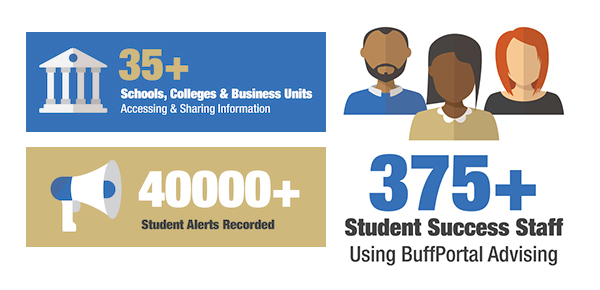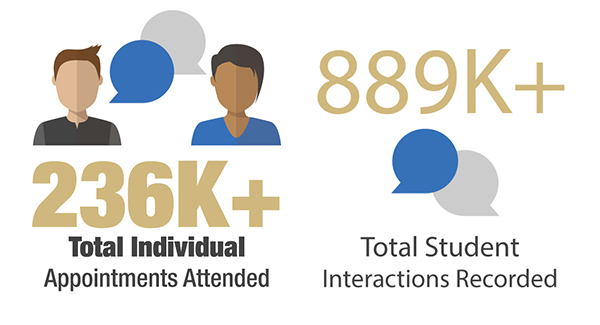MyCUHub, errrr, Buff Portal Advising Turns 5!!
Remember MyCUHub? Why, it seems like just yesterday that MyCUHub was a new app rolling out campus-wide. Hard as it may be to believe, it celebrated its five year birthday in 2020 and, as part of wider campus initiatives, took the new name of Buff Portal Advising (or “BPA”).
At first somewhat exclusively intended for use by academic advisors, Buff Portal Advising now helps staff in many and diverse functional areas to support our students -- academic advising and student success, yes, but also tutoring centers, athletics, New Student and Family Programs, and more. Built on Salesforce.com (a CRM, or Constituent Relationship Management-type platform), the system creates a holistic record of students’ experiences with advising and advising-related student support staff. With each new user and office, we’ve come closer to realizing the ultimate vision for what we set out to do: improve the student experience by sharing relevant notes about interactions with students and coordinating our support of them.
While still looking forward to the ongoing mission, the five-year mark is a good time to reflect on how much we’ve accomplished together and look ahead to what the next five years could bring...
A plan with a purpose
Though first use of the system started five years ago, planning for it actually started in 2012-2013 when a cross-campus group aimed to adopt a campus-wide system (or set of systems) for advising and student success activities. By May 2013, we reviewed Starfish, GradesFirst, and Salesforce, among others. In what has been called a “horse race” comparative study, Salesforce emerged the winner.
It could not have happened without a strong endorsement from campus leaders and an ambitious vision. In his 2014 State of the Campus address, Chancellor DiStefano anticipated that this platform, “would help our advisors take a holistic approach to advising while collaborating across campus as a coordinated community for the benefit of our students…. This centralized system will provide a cohesive network of information and support for students that spans departments, offices, colleges and eventually campuses.”
Later, in 2015, Provost Russ Moore referred to this project as a student success system, aimed at “effectively integrating disparate processes, systems and tools to provide our students with a consistent experience when interacting with campus offices and representatives.” By 2019, the name change to Buff Portal Advising was the integration of MyCUHub into the larger Unified Student Experience (USE) project. In fact the USE project grew out of these long standing desires to integrate disparate systems and user experiences and MyCUHub was an important underpinning to that work.
MyCUHub was so...dreamy
Prior to MyCUHub, most advising units relied on paper-based recordkeeping or had developed internal electronic systems to manage their work. These early efforts were well liked across the advising community but were limited in scope--when students changed their major and advisor, a paper file followed; advisors logged-in separately to the several web-based tools, like CU-SIS and DARS.
An early rallying point for the design team was the notion of a “Dream Console” -- words that may evoke a rather plush advising system. In our early sketches with the developers, working teams of advisors felt that having a picture of the student, a common view for students and staff, deep links to campus solutions and the degree audit, and everything in one singular view would be a "dream." We still see the reference to it in our web browser tab today.
Ready set...launch!
While 2015 is widely remembered and regarded as the official rollout date, in 2014 the CRM team, in tandem with a small, tactical advisory group, piloted a simple timing application on Salesforce to record the amount of time advisors were spending with students. The promise that this pilot demonstrated motivated the team to keep going with the full design and rollout of the full MyCUHub application. And on May 4, 2015 (“May the Hub Be With You”), OIT announced the rollout to 128 academic advising users across campus colleges and schools.
Initially, key features of the system included appointment calendaring and reservations, integrated notes and messaging, and integration of student information from various campus systems. Since that time, the system has grown to roughly 400 student success users across more than 30 campus units.


Over the past five years, functionality has expanded to include:
- Appointment and drop-in queueing
- Event attendance tracking
- Integrated mass messaging with engagement metrics
- Meeting check-in with BuffOne card, IdentiKey, or SID
- Midterm course alerts
- Placement assessment integrations for: Language, Math, Strengths
- Tutoring and study yall check-in & tracking
- Varied meeting formats: in-person, phone, video advising
Over the past five years, the system has faciliated:


What have we learned and accomplished together
A system can only take you so far without the mindset and desire to change, adopt, and adapt. While our initial venture into developing a shared advising tool is considered successful, much of what we’ve accomplished has been cultural change within the advising community -- from the change that was part of moving to a shared digital environment to pioneering common elements across disparate units and processes. We’re grateful that we’ve created a culture of collaboration and co-ownership.
Like any five-year-old, BPA has had its ups and downs and has gotten better at a lot of things in a short period of time (though we’re happy we avoided the worst of the “Terrible Twos”). In these early years we’ve experimented with sponsorship, governance, and how best to respond to development requests that are many and varied. Aiming to be intentional about how the tool should evolve, some of our growth spurts were exuberantly celebrated (logging directly from Outlook with Lightning) and others left us all collectively pouting (calendar syncing with the Riva plug-in).
We’ve learned that not all staff agree about how best to use BPA; we’ve learned that students don’t always think what we think they think; and we’ve learned that not everything can be automated. We’ve also learned that where new development has been most useful, it’s been when everyone using and building BPA works as a team. We have always strived to build new software that people will not just use, but want to use.

What’s next?
As we look ahead to the next five years, we will focus on a few key goals, including streamlining the scope and core mission of BPA, improving the user experience, and building tools that facilitate proactive and focused outreach to students.
Streamlining the scope of BPA
What we wanted originally was a tool for academic advisors that focused on calendaring and logging notes about interactions with students. That’s it. Seems pretty simple, right?
Yet before we even launched in 2015, the scope expanded to a vision of an inclusive student success system. The Provost’s Office and growing interest desired a coordinated method for identifying places for “early alerts” and proactive outreach to students at risk. Much more than a simple calendar or “To Do list,” Buff Portal Advising creates a space to do just that, supported by a host of metrics and data that afford much better opportunities to lift up students when they may be struggling.
We remain committed to further developing Buff Portal Advising to empower advising and success/care team staff to take proactive approaches to supporting students and increasing student persistence.
Streamlining the user experience
Standardized best practices and protocols for using BPA remain a goal. Identifying common practices allows us to approach student support more cohesively as a campus community. It also lets us work with students in need of additional assistance. And it enables other critical reporting needs. Over the next year, we’ll be partnering with end-users to establish protocols for BPA best practices.
We will also adjust the user experience and the overall look of the BPA tool. Similar to efforts being made on the larger Buff Portal project, we will take a user design approach that solicits input from users, both staff and students, as we identify areas for improvement and hone functionality. Simpler is often better, and we’re striving for a complete, but not complex, vision for displaying the elements advisors and students care about most.
Building tools that promote student persistence
Over the past five years, we've been busy building a strong foundation and increasing adoption across campus units. We can now focus on one of the Provost’s goals for this initiative of “leveraging data to alert us when a student needs connections so that our student success teams can more effectively match coordinated university actions with student's needs.” Our collective success will rely heavily on the involvement of all of our campus partners in developing functionality and consistently applying standardized best practices.
We -- all of us, including the CRM team, Student Success professionals, faculty, and staff -- are dedicated to supporting students throughout their academic journey. CRM will be aligning resources in support of our common mission. We look forward with eagerness to the next five years and how the system can expand its suite of functionality to support our ever-changing needs and student population.
